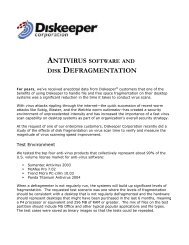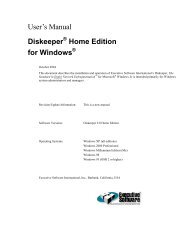Diskeeper 10 User's Manual
Diskeeper 10 User's Manual
Diskeeper 10 User's Manual
You also want an ePaper? Increase the reach of your titles
YUMPU automatically turns print PDFs into web optimized ePapers that Google loves.
24 <strong>Diskeeper</strong> Operation<br />
Excess Directory Fragments<br />
This section of the Job Report tab or event log entry shows the total number of directory fragments on the disk<br />
volume. Contiguous directories are not counted in this total, but each additional piece of any fragmented<br />
directory is counted.<br />
Total Files<br />
This section of the Job Report tab or event log entry shows the total number of files on the disk volume. This<br />
number does not include zero-length files or (in most cases) files less than one cluster in size on NTFS<br />
volumes. Files less than one cluster in size may be included, depending on the file size and the cluster size.<br />
Average File Size<br />
This section of the Job Report tab or event log entry shows the average size of all the files on the disk volume.<br />
This number does not include any zero-length files or paging files.<br />
Total Fragmented Files<br />
This section of the Job Report tab or event log entry shows the total number of fragmented files on the disk<br />
volume.<br />
Total Excess Fragments<br />
This section of the Job Report tab or event log entry shows the total number of file fragments on the disk<br />
volume. Contiguous files are not counted in this total, but each additional piece of any fragmented file is<br />
counted.<br />
Average Fragments per File<br />
This section of the Job Report tab or event log entry shows the average number of fragments per file on the disk<br />
volume. This is a good index of how fragmented the files on the volume are.<br />
If the average fragment per file figure is 1.00, the files are contiguous. If the figure is 1.<strong>10</strong>, then <strong>10</strong>% of the<br />
files, on average, are in two pieces. 1.20 means 20%, 1.30 means 30%, etc. A figure of 2.00 means the files<br />
average two fragments each. 1.00 is the best figure attainable, indicating that all files or nearly all files are<br />
contiguous.<br />
Files with Performance Loss<br />
This section of the Job Report tab or event log entry shows the number of files for which fragmentation is<br />
causing a loss in performance. For example, although it is fragmented, a large file in two pieces will not exhibit<br />
any significant performance loss, so it would not be included in this figure.<br />
Paging/Swap File Size<br />
This section of the Job Report tab or event log entry shows the size of the paging file (or swap file on Windows<br />
98/Me systems) on the disk volume. This section displays zero when no paging file is present.<br />
Total Fragments<br />
This section of the Job Report tab or event log entry shows the number of fragments the paging file is broken<br />
into (if it exists on the disk volume).<br />
Total MFT Size<br />
This section of the Job Report tab or event log entry shows the size of the Master File Table (MFT).<br />
Since the MFT is only used on NTFS volumes, this section is not displayed for FAT volumes in the text<br />
analysis display, and shows as zeros in the event log.<br />
MFT Records in Use<br />
This section of the Job Report tab or event log entry shows the number of individual file records found in the<br />
Master File Table (MFT). This figure will not necessarily correspond with the number of files presently on the<br />
volume, since the file records remain in the MFT, even after a file is deleted.






